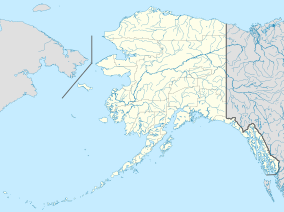Izembek National Wildlife Refuge facts for kids
Quick facts for kids Izembek National Wildlife Refuge |
|
|---|---|
|
IUCN Category IV (Habitat/Species Management Area)
|
|
| Location | Aleutians East Borough, Alaska, United States |
| Nearest city | Cold Bay, Alaska |
| Area | 315,000 acres (1,270 km2) |
| Established | 1980 |
| Governing body | U.S. Fish and Wildlife Service |
| Website | Izembek NWR |
| Official name: Izembek Lagoon National Wildlife Refuge | |
| Designated: | 18 December 1986 |
| Reference #: | 349 |
The Izembek National Wildlife Refuge is a special protected area in Alaska, one of the U.S. states. It is located on the northwest coast of the Aleutians East Borough, facing the Bering Sea. It is the smallest of the National Wildlife Refuges in Alaska.
Most of this refuge, about 307,982 acres (124,636 hectares), was set aside as a "wilderness area" in 1980. This means it is kept as natural as possible, with very little human impact. The refuge is managed by offices in Cold Bay, Alaska.
Izembek National Wildlife Refuge sits between the rich waters of the Bering Sea and the Gulf of Alaska. At its heart is Izembek Lagoon. This lagoon is about 30 miles (48 km) long and 5 miles (8 km) wide. It has one of the world's biggest beds of eelgrass. This eelgrass is a very important food source for many animals.
More than 200 types of wildlife and nine kinds of fish live in the refuge. Millions of birds that travel long distances, called migratory waterfowl and shorebirds, use the lagoons and freshwater wetlands. They find food and shelter here on their journeys to and from their breeding grounds in the subarctic and arctic regions.
Because so many different kinds of birds gather here, Izembek has gained international attention. In 1986, Izembek National Wildlife Refuge and Izembek State Game Refuge became the first wetland in the United States to be recognized by the Ramsar Convention. This convention helps protect important wetlands around the world. In 2001, the National Audubon Society also named Izembek Refuge a Globally Important Bird Area.
Protecting Izembek: The Road Debate
For many years, there have been discussions about building a road through the refuge. This road would connect the towns of King Cove and Cold Bay.
One plan suggested trading 43,000 acres (17,000 hectares) of land from Alaska and the King Cove Corporation. In return, a 17-mile (27 km) single-lane road would be built through Izembek National Wildlife Refuge. However, environmental groups worried that this road would harm the population of black brant geese and other animals that rely on the refuge. In 2013, the Department of the Interior stopped this land trade.
In 2018, a different land trade agreement was proposed. Nine environmental groups quickly sued the government. They argued that a study had already shown the road was not needed and would cause lasting damage to the refuge. In March 2019, a court ruled against the road plan again. The court said that trying to remove land from the refuge went against the existing environmental study. A second judge also rejected a new plan in June 2020.
Amazing Animals of Izembek
Izembek Wilderness is a vital home for many animals. Every fall, about a quarter-million migratory birds visit, including almost all the world's black brant geese. Thousands of Canada and emperor geese also come here. You can also spot Steller's eiders and many types of ducks and shorebirds.
The huge eelgrass beds in Izembek Lagoon provide lots of food and shelter for these birds. Tundra swans live in the refuge all year round. Thousands of gray, minke, and orca whales swim along the coast during their migrations. Hundreds of thousands of salmon also come to the wilderness to lay their eggs.
Other common animals in the wilderness include brown bears, seals, walruses, Steller's sea lions, sea otters, and caribou. These caribou belong to the Southern Alaska Peninsula herd.
You might also see red foxes and caribou roaming the refuge. Large birds of prey, called raptors, hunt for rodents, birds, and fish in this area. These include bald and golden eagles, rough-legged hawks, gyrfalcons, and Peale's peregrine falcons.
Marine mammals are often found in the rich waters around the refuge. Harbor seals, Steller's sea lions, and sea otters live in the nearby coastal waters and lagoons. Harbor seals often rest on sandbars in the lagoons and along the coast. Sometimes, orcas, gray whales, and minke whales can be seen migrating along the shoreline, and sometimes even inside Izembek Lagoon.
Images for kids
See also
 In Spanish: Refugio Nacional de Vida Silvestre de Izembek para niños
In Spanish: Refugio Nacional de Vida Silvestre de Izembek para niños







